Uncertainty of Estimated Rainflow Damage in Stationary Random Loadings and in Those Stationary per partes
Abstract
:1. Introduction
2. Expected Fatigue Damage for a Random Loading
3. Confidence Interval of Damage: Stationary Case
3.1. Case M: Multiple Stress-Time Histories
3.2. Case S: Single Stress-Time History
4. Confidence Interval of Damage: Non-Stationary Case
4.1. Confidence Interval on the Sum of Independent Normal Random Variables
4.2. Confidence Interval of Damage for a Switching Loading with Two or More States
5. Verification by Simulated Switching Loadings
5.1. Simulation of Load Cases
- Load B: same and as Load A but with different lengths with values: s (state 1), (state 2), s (state 3);
- Load C: sequence of four states arranged in a random sequence. Since states 1 and 2 appear twice (see Figure 4a), the analysis requires a state reordering (the reordered sequence, with full state lengths , is shown in Figure 4b). States have the following characteristics: s, , (state 1); , , (state 2); s, and (state 3); s, , (state 4).
5.2. Simulation Results
6. Verification by Loadings Measured in a Mountain Bike
6.1. Methods and Data Acquisition
- 10 stationary records used as input for Case M in Section 3.1.
- 1 stationary record used as input for Case S in Section 3.2.
- 30 stationary records to form the validation set for the stationary case.
- 1 non-stationary switching record to be analyzed as in Section 4.2.
- 20 non-stationary switching records for the validation set of the non-stationary case.
6.2. Detecting Stationarity/Non-Stationarity by the Run Test
6.3. Experimental Verification of Confidence Intervals: Stationary Case
6.4. Experimental Verification of Confidence Intervals: Non-Stationary Case
7. Conclusions
- subdivision into states and blocks determines a negligible loss of fatigue cycles compared to the cycles counted in each state/block, which is especially valid when the stress-time history has negligible or no variation in its mean value among different stationary states;
- in numerical simulations, the estimated confidence level was almost coincident with the theoretical value of 95% for any number of block subdivisions, thus confirming the accuracy of the proposed method. A slightly larger confidence (98.1%) characterizes the limit case of two block subdivisions, which is indeed not recommended;
- in both simulations and experiments, the width of the confidence interval decreases as the number of blocks increases, until it approaches a sort of limit value characterizing the inherent randomness of the considered random loading. This trend then suggests the use of the largest possible number of block subdivisions, provided that a sufficient number of cycles remains within each block;
- the run test proved to be a powerful tool for classifying the measured records as stationary or non-stationary, regardless of the window length chosen in the analysis;
- the upper value of the confidence interval may be used as a reference damage value in a structural durability assessment.
Supplementary Materials
Author Contributions
Funding
Data Availability Statement
Conflicts of Interest
References
- Schütz, W.; Klätschke, H.; Hück, M.; Sonsino, C.M. Standardized load sequence for offshore structures—WASH 1. Fatigue Fract. Eng. Mater Struct. 1990, 13, 15–29. [Google Scholar] [CrossRef]
- Buch, A. Prediction of the comparative fatigue performance for realistic loading distributions. Prog. Aeosp. Sci. 1997, 33, 391–430. [Google Scholar] [CrossRef]
- Leser, C.; Thangjitham, S.; Dowling, N.E. Modelling of random vehicle loading histories for fatigue analysis. Int. J. Vehicle Design 1994, 15, 467–483. [Google Scholar] [CrossRef]
- Bel Knani, K.; Benasciutti, D.; Signorini, A.; Tovo, R. Fatigue damage assessment of a car body-in-white using a frequency-domain approach. Int. J. Mater. Prod. Technol. 2007, 30, 172–198. [Google Scholar] [CrossRef]
- Schijve, J. Fatigue of Structures and Materials, 2nd ed.; Springer: Berlin, Germany, 2009. [Google Scholar]
- Mark, W.D. The Inherent Variation in Fatigue Damage Resulting from Random Vibration. Ph.D. Thesis, Department of Mechanical Engineering, M.I.T., Cambridge, MA, USA, 1961. [Google Scholar]
- Crandall, S.H.; Mark, W.D.; Khabbaz, G.R. The variance in Palmgren-Miner damage due to random vibration. In Proceedings of the 4th US National Congress of Applied Mechanics, Berkeley, CA, USA, 18–21 June 1962; Rosenberg, R.M., Ed.; American Society of Mechanical Engineers (ASME): New York, NY, USA; Volume 1, pp. 119–126. [Google Scholar]
- Crandall, S.H.; Mark, W.D. Random Vibration in Mechanical Systems; Academic Press: New York, NY, USA, 1963. [Google Scholar]
- Bendat, J.S. Probability Functions for Random Responses: Prediction of Peaks, Fatigue Damage, and Catastrophic Failures; NASA CR-33; Measurement Analysis Corporation: Torrance, CA, USA, 1964. [Google Scholar]
- Madsen, H.O.; Krenk, S.; Lind, N.C. Methods of Structural Safety; Prentice-Hall: Hoboken, NJ, USA, 1986. [Google Scholar]
- Low, Y.M. Variance of the fatigue damage due to a Gaussian narrowband process. Struct. Saf. 2012, 34, 381–389. [Google Scholar] [CrossRef]
- Low, Y.M. Uncertainty of the fatigue damage arising from a stochastic process with multiple frequency modes. Probab. Eng. Mech. 2014, 36, 8–18. [Google Scholar] [CrossRef]
- Marques, J.M.E.; Benasciutti, D.; Tovo, R. Variability of the fatigue damage due to the randomness of a stationary vibration load. Int. J. Fatigue 2020, 141, 105891. [Google Scholar] [CrossRef]
- Marques, J.M.E.; Benasciutti, D. Variance of the fatigue damage in non-Gaussian stochastic processes with narrow-band power spectrum. Struct. Saf. 2021, 93, 102131. [Google Scholar] [CrossRef]
- Bengtsson, A.; Bogsjö, K.; Rychlik, I. Uncertainty of estimated rainflow damage for random loads. Mar. Struct. 2009, 22, 261–274. [Google Scholar] [CrossRef]
- Farid, M. Data-driven method for real-time prediction and uncertainty quantification of fatigue failure under stochastic loading using artificial neural networks and Gaussian process regression. Int. J. Fatigue 2022, 155, 106415. [Google Scholar] [CrossRef]
- Lim, H.; Lance, M.; Low, Y.M.; Srinil, N. A surrogate model for estimating uncertainty in marine riser fatigue damage resulting from vortex-induced vibration. Eng. Struct. 2022, 254, 113796. [Google Scholar] [CrossRef]
- Chen, J.; Imanian, A.; Wei, H.; Iyyer, N.; Liu, Y. Piecewise stochastic rainflow counting for probabilistic linear and nonlinear damage accumulation considering loading and material uncertainties. Int. J. Fatigue 2020, 140, 105842. [Google Scholar] [CrossRef]
- Liu, X.; Wang, H.; Wu, Q.; Wang, Y. Uncertainty-based analysis of random load signal and fatigue life for mechanical structures. Arch. Computat. Methods Eng. 2022, 29, 375–395. [Google Scholar] [CrossRef]
- Dong, Y.; Garbatov, Y.; Guedes Soares, C. Review on uncertainties in fatigue loads and fatigue life of ships and offshore structures. Ocean Eng. 2022, 264, 112514. [Google Scholar] [CrossRef]
- Wang, S.; Moan, T.; Jiang, Z. Influence of variability and uncertainty of wind and waves on fatigue damage of a floating wind turbine drivetrain. Renew. Energy 2022, 181, 870–897. [Google Scholar] [CrossRef]
- Alduse, B.P.; Jung, S.; Vanli, O.A.; Kwon, S.-D. Effect of uncertainties in wind speed and direction on the fatigue damage of long-span bridges. Eng. Struct. 2015, 100, 468–478. [Google Scholar] [CrossRef]
- Abdullah, L.; Singh, S.S.K.; Abdullah, S.; Azman, A.H.; Ariffin, A.K. Fatigue reliability and hazard assessment of road load strain data for determining the fatigue life characteristics. Eng. Fail. Anal. 2021, 123, 105314. [Google Scholar] [CrossRef]
- Zhang, Y.; Liu, X.; Yu, X.; Wang, X.; Wang, X. Reliability analysis of excavator boom considering mixed uncertain variables. Qual. Reliab. Eng. Int. 2021, 37, 1468–1483. [Google Scholar] [CrossRef]
- Wirsching, P.H. Statistical summaries of fatigue data for design purposes. In NASA Technical Report CR-3697; NASA: Washington, DC, USA, 2013. [Google Scholar]
- Shen, C.L.; Wirsching, P.H.; Cashman, G.T. Design curve to characterize fatigue strength. J. Eng. Mater. Technol. Trans. ASME 1996, 118, 535–541. [Google Scholar] [CrossRef]
- Montgomery, D.C.; Runger, G.C. Applied Statistics and Probability for Engineers, 6th ed.; John Wiley & Sons: Hoboken, NJ, USA, 2014. [Google Scholar]
- Desmond, A.F. On the distribution of the time to fatigue failure for the simple linear oscillator. Probab. Eng. Mech. 1987, 2, 214–218. [Google Scholar] [CrossRef]
- Low, Y.M. An analytical formulation for the fatigue damage skewness relating to a narrowband process. Struct. Saf. 2012, 35, 18–28. [Google Scholar] [CrossRef]
- Welch, B.L. The generalization of ‘Student’s’ problem when several different population variances are involved. Biometrika 1947, 34, 28–35. [Google Scholar] [CrossRef] [PubMed]
- Marques, J.M.E. Confidence intervals for the expected damage in random loadings: Application to measured time-history records from a Mountain-bike. IOP Conf. Ser. Mater. Sci. Eng. 2021, 1038, 012025. [Google Scholar] [CrossRef]
- Johannesson, P. Rainflow cycles for switching processes with Markov structure. Probab. Eng. Inform. Sc. 1998, 12, 143–175. [Google Scholar] [CrossRef] [Green Version]
- Wald, A.; Wolfowitz, J. On a test whether two samples are from the same population. Ann. Math. Stat. 1940, 11, 147–162. [Google Scholar] [CrossRef]
- Mood, A.M. The distribution theory of runs. Ann. Math. Stat. 1940, 11, 367–392. [Google Scholar] [CrossRef]
- Hald, A. Statistical Theory with Engineering Applications; John Wiley & Sons: Hoboken, NJ, USA, 1955. [Google Scholar]
- Swed, F.S.; Eisenhart, C. Tables for testing randomness of grouping in a sequence of alternatives. Ann. Math. Stat. 1943, 14, 66–87. [Google Scholar] [CrossRef]
- Brownlee, K.A. Statistical Theory and Methodology in Science and Engineering, 2nd ed.; John Wiley & Sons: Hoboken, NJ, USA, 1965. [Google Scholar]
- Rouillard, V. Quantifying the non-stationarity of vehicle vibrations with the run test. Packag. Technol. Sci. 2014, 27, 203–219. [Google Scholar] [CrossRef]
- Killick, R.; Fearnhead, P.; Eckley, I.A. Optimal detection of changepoints with a linear computational cost. J. Am. Stat. Assoc. 2012, 107, 1590–1598. [Google Scholar] [CrossRef]

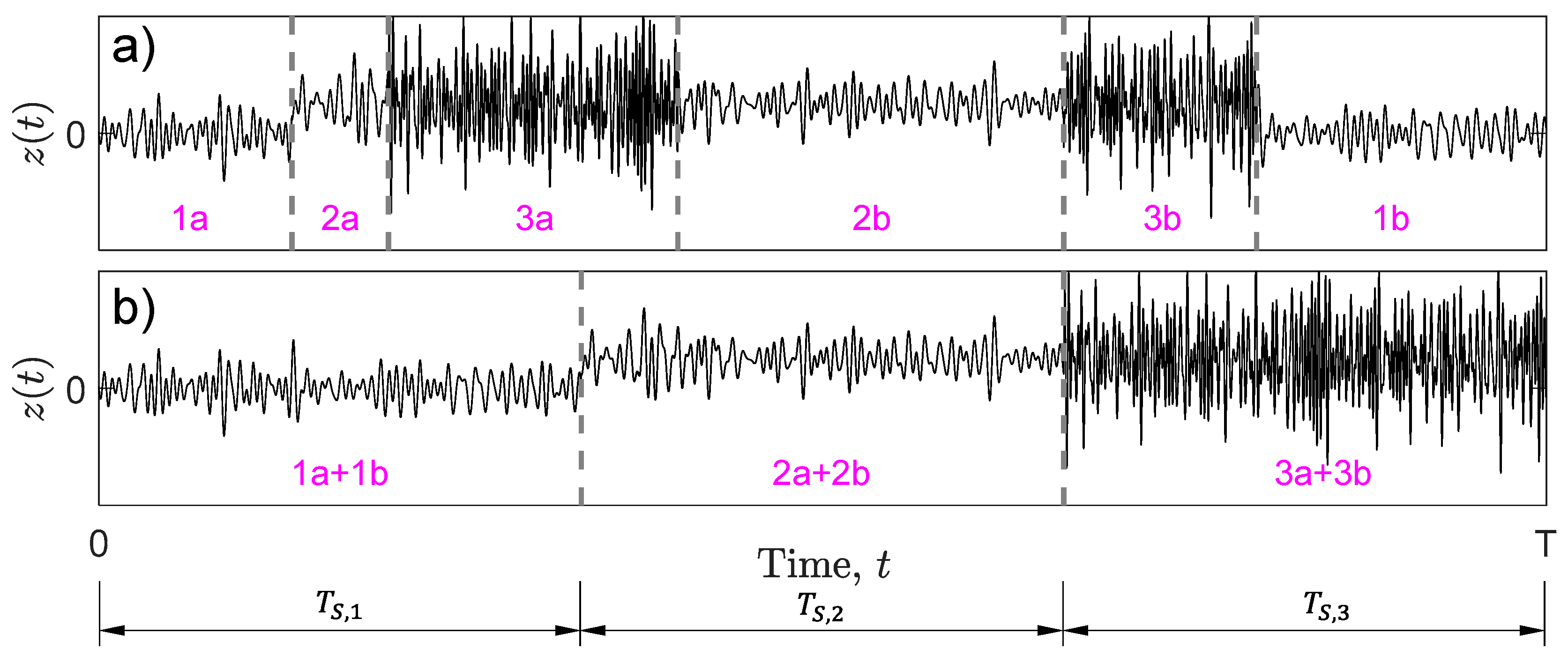
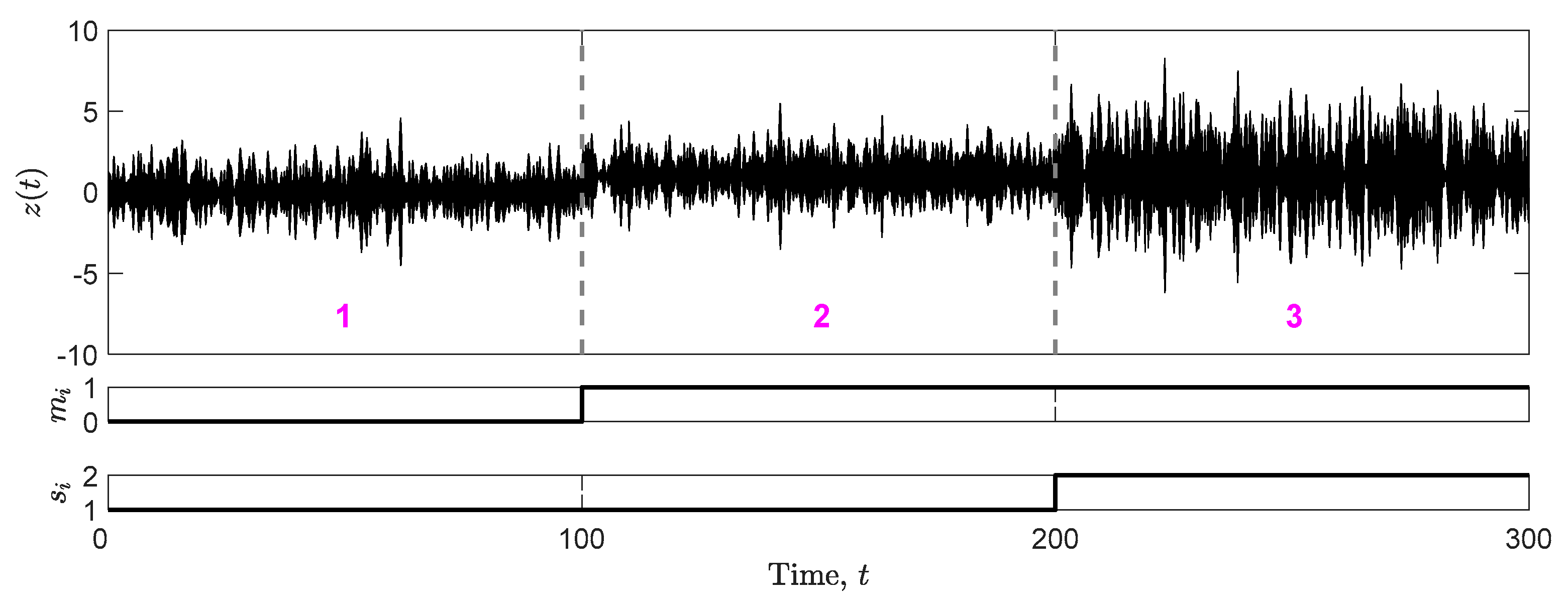
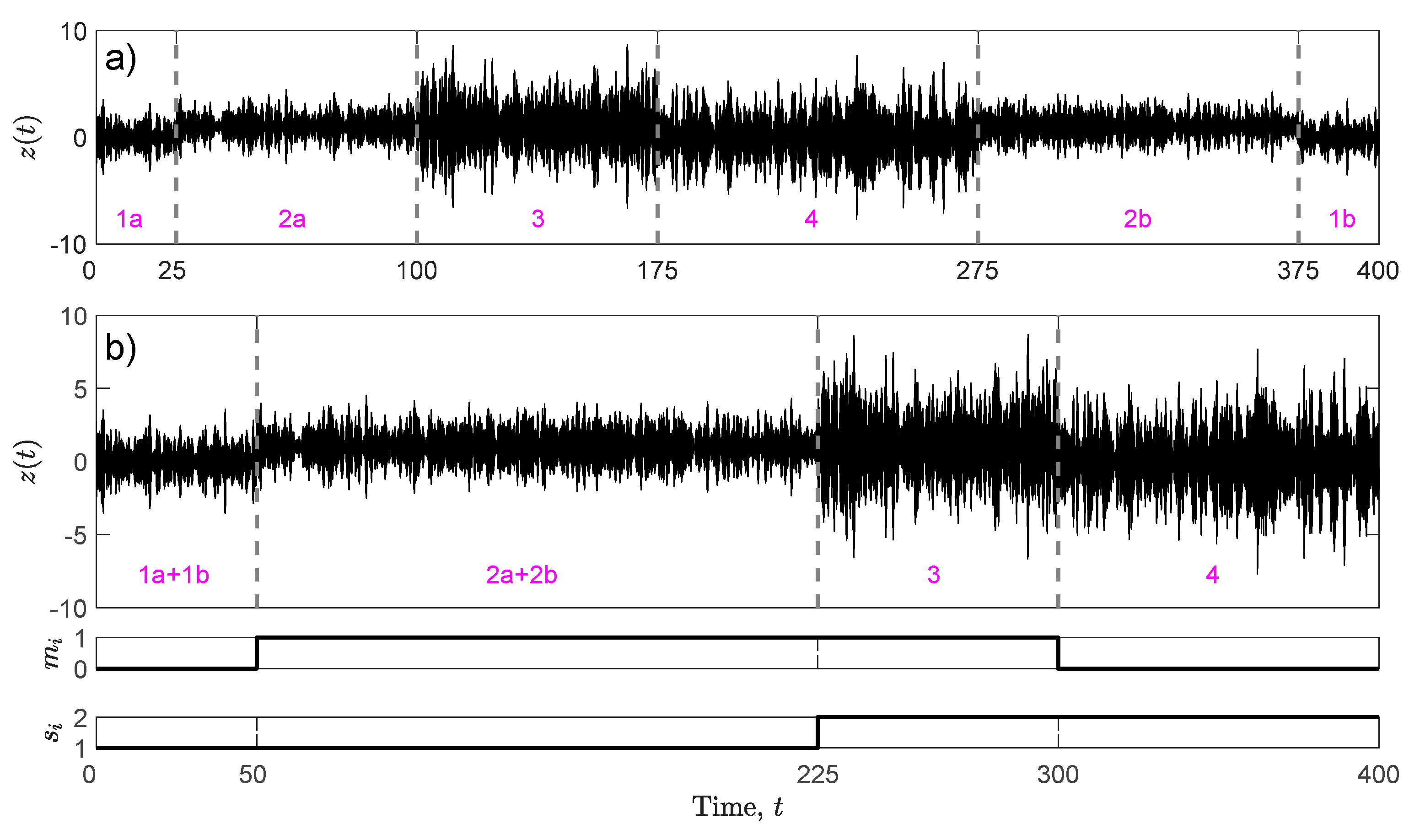
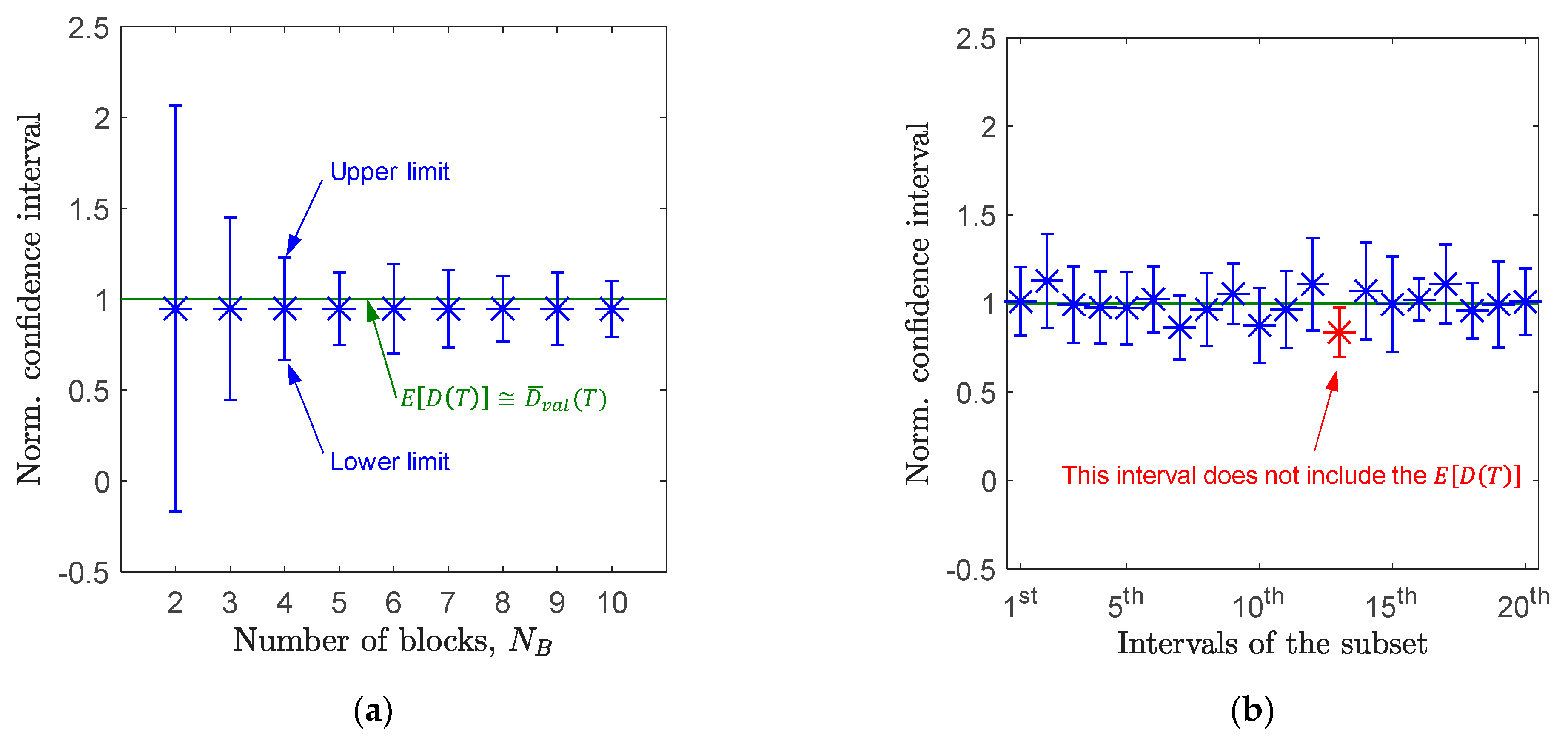
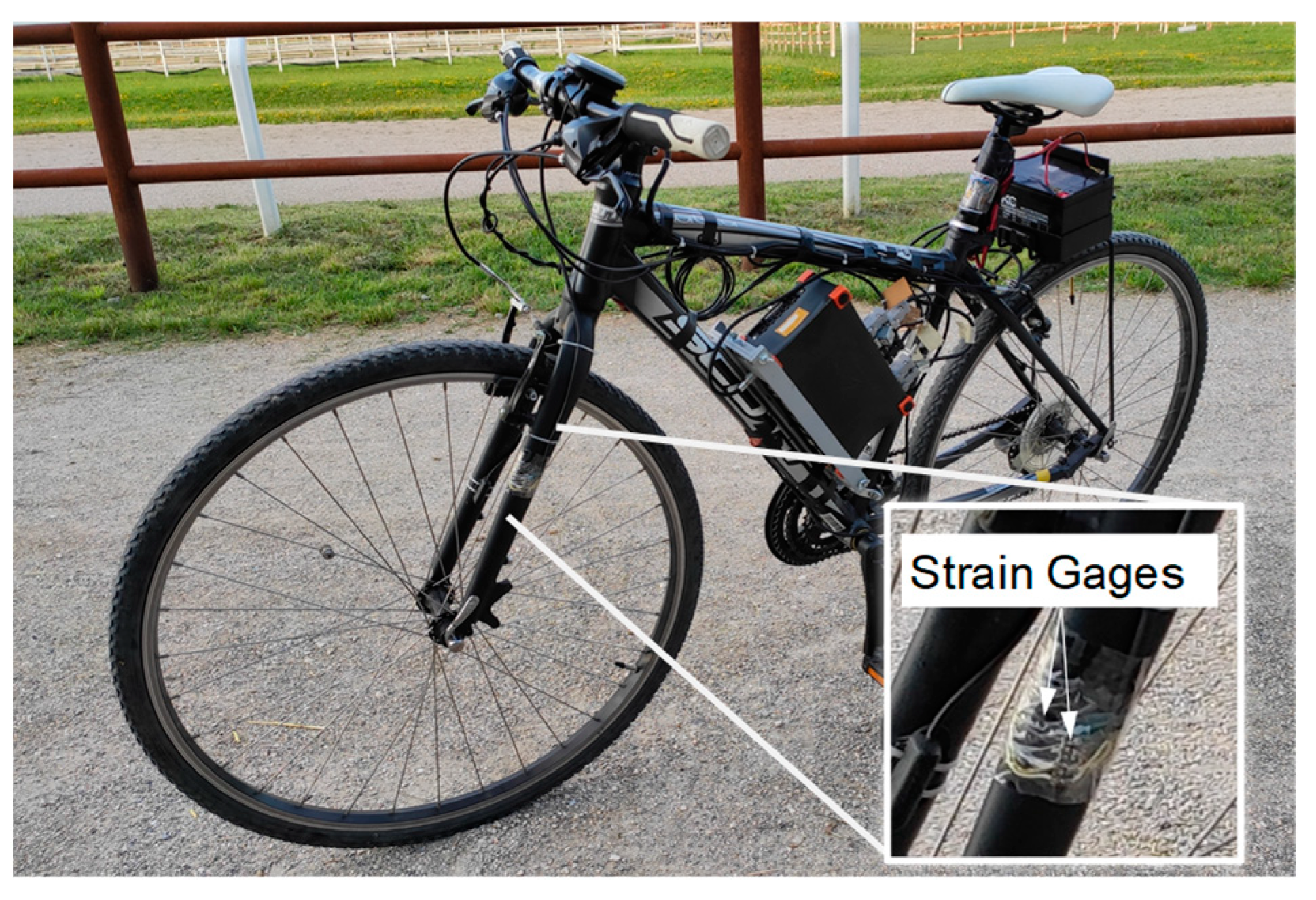

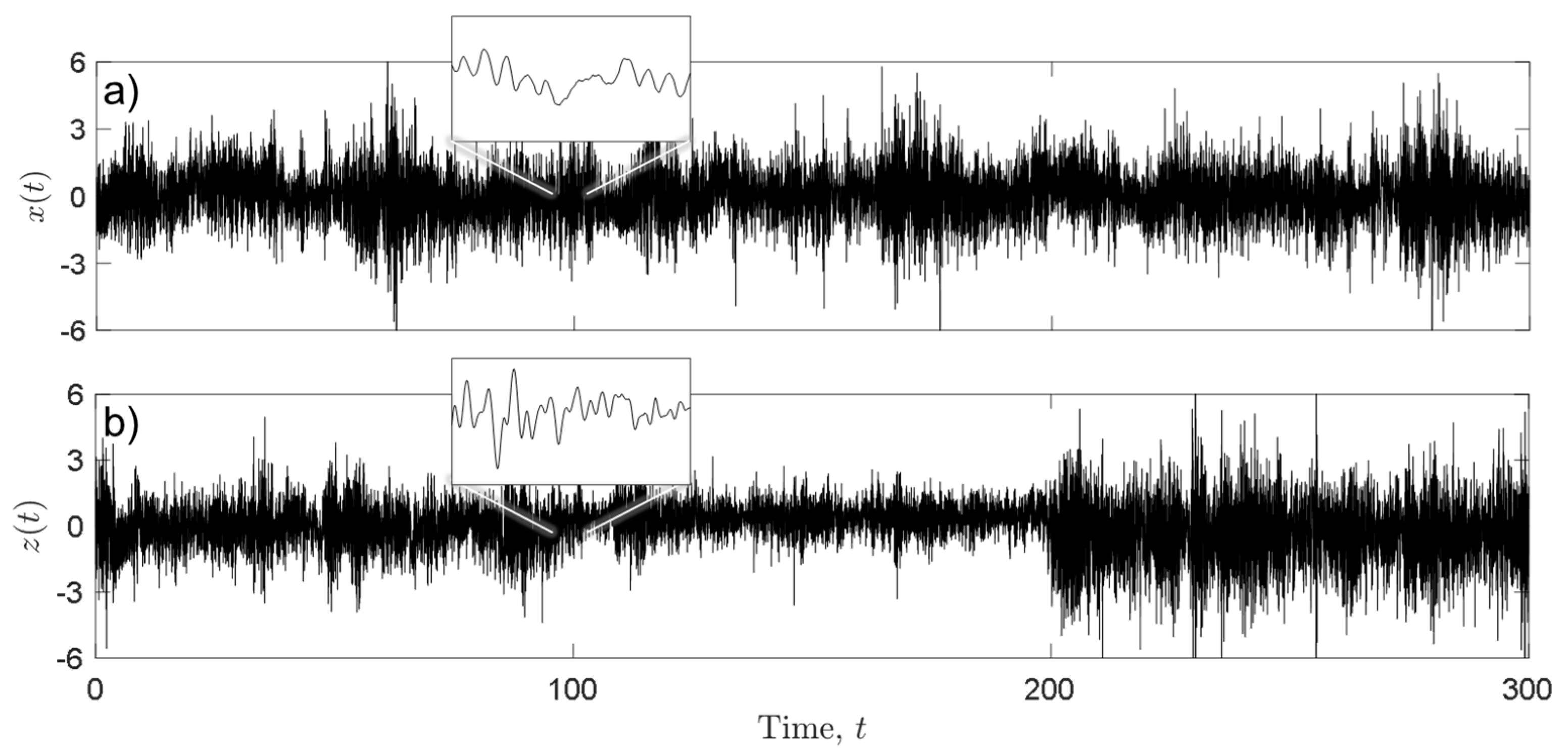
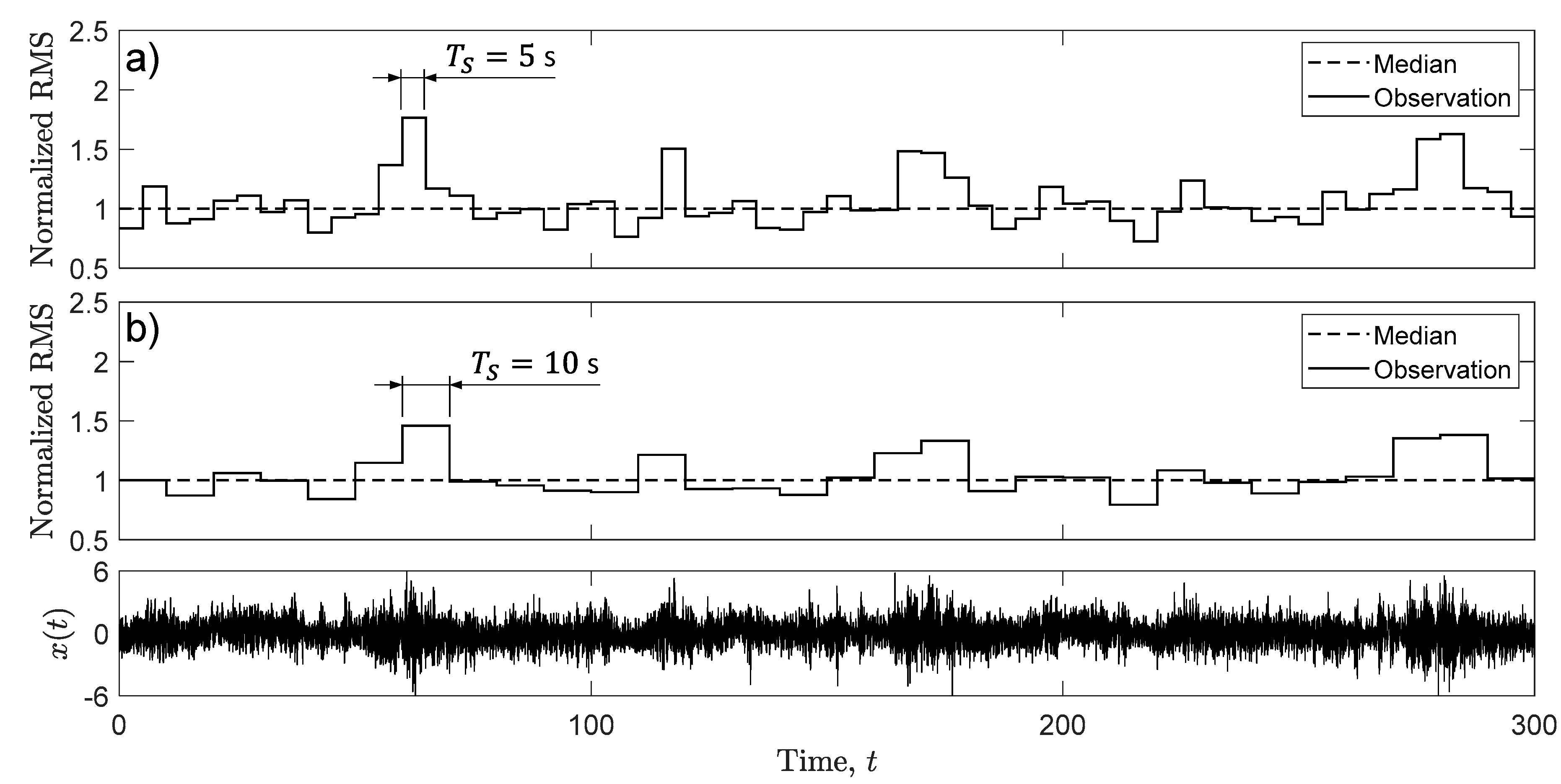
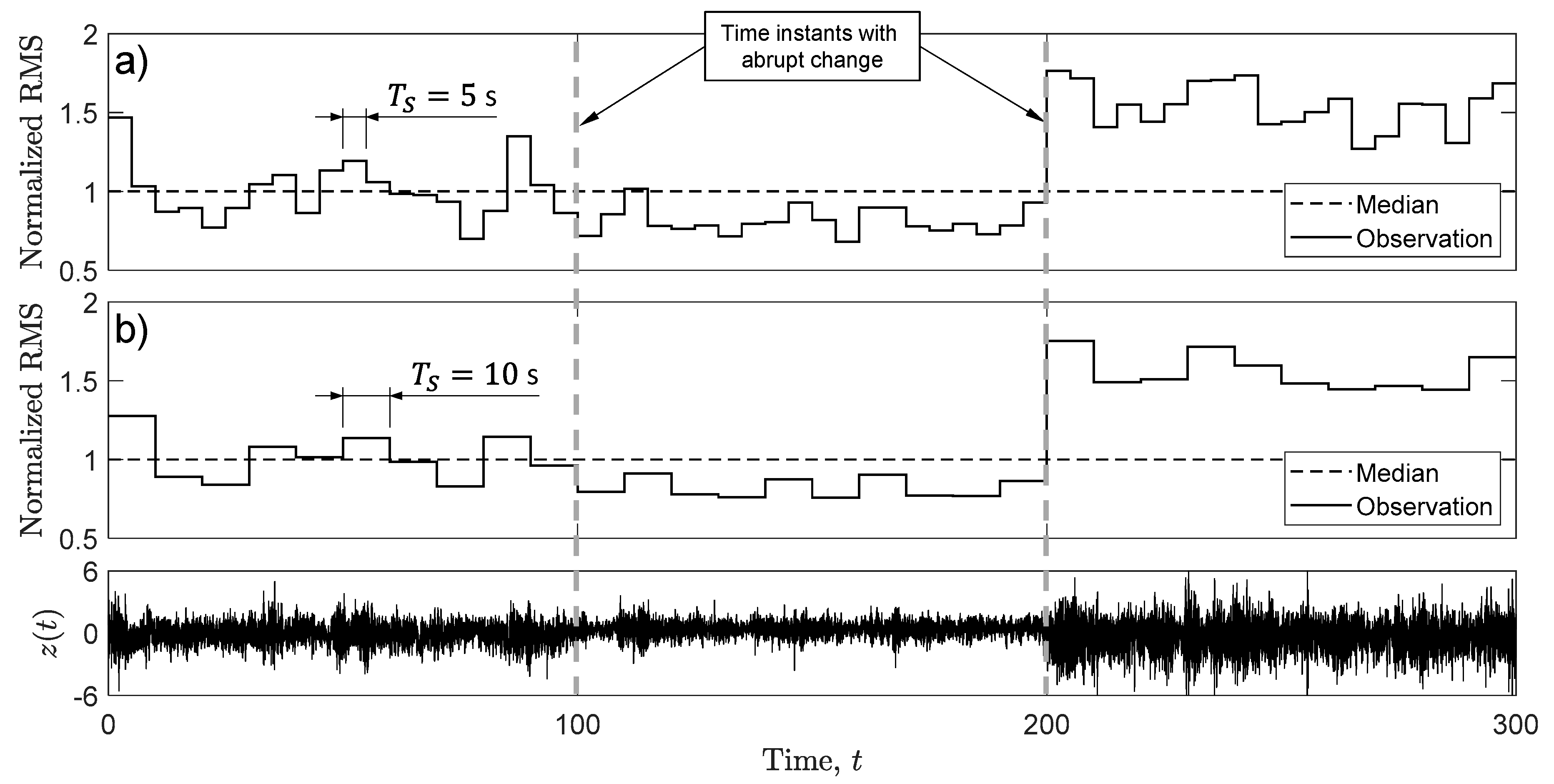
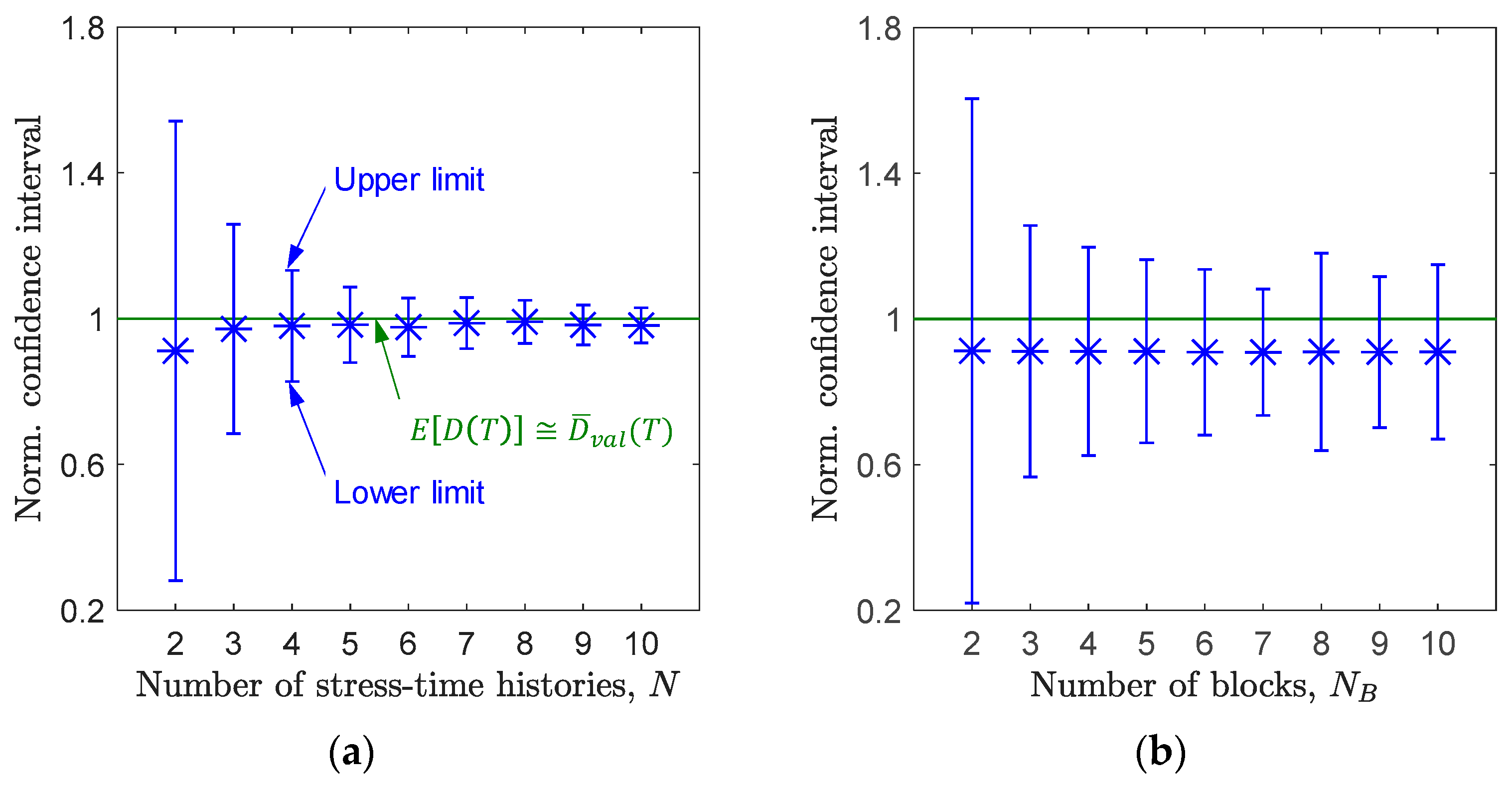

| Parameters | ||||||
|---|---|---|---|---|---|---|
| 1 | 2 | 3 | 4 | 5 | 6 | |
| Expected value, | 0 | 0 | 0 | 0 | 1 | 1 |
| Variance, | 1 | 5 | 10 | 100 | 1 | 5 |
| 2 | 3 | 4 | 5 | 6 | |
|---|---|---|---|---|---|
| 98.47% | 98.24% | 95.96% | 95.82% | 94.90% | |
| 95.08% | 95.05% | 95.08% | 95.07% | 95.11% | |
| 95.00% | 95.01% | 95.00% | 95.02% | 95.00% | |
| Case M | Case S | ||||
|---|---|---|---|---|---|
| 2 | 0.912 | 1.048 | 2 | 0.913 | 0.814 |
| 3 | 0.972 | 1.727 | 3 | 0.911 | 1.198 |
| 4 | 0.980 | 1.430 | 4 | 0.911 | 1.342 |
| 5 | 0.983 | 1.243 | 5 | 0.911 | 1.353 |
| 6 | 0.977 | 1.138 | 6 | 0.909 | 1.322 |
| 7 | 0.988 | 1.130 | 7 | 0.909 | 1.059 |
| 8 | 0.992 | 1.057 | 8 | 0.910 | 1.712 |
| 9 | 0.983 | 1.062 | 9 | 0.909 | 1.343 |
| 10 | 0.982 | 1.003 | 10 | 0.910 | 1.582 |
| Statistics for Confidence Intervals | |||
|---|---|---|---|
| 2 | 1.086 | 1 | 0.767 |
| 3 | 1.087 | 2 | 0.559 |
| 4 | 1.083 | 3 | 0.579 |
| 5 | 1.085 | 5 | 0.566 |
| 6 | 1.081 | 7 | 0.506 |
| 7 | 1.081 | 7 | 0.740 |
| 8 | 1.079 | 8 | 0.606 |
| 9 | 1.078 | 10 | 0.651 |
| 10 | 1.076 | 12 | 0.587 |
Disclaimer/Publisher’s Note: The statements, opinions and data contained in all publications are solely those of the individual author(s) and contributor(s) and not of MDPI and/or the editor(s). MDPI and/or the editor(s) disclaim responsibility for any injury to people or property resulting from any ideas, methods, instructions or products referred to in the content. |
© 2023 by the authors. Licensee MDPI, Basel, Switzerland. This article is an open access article distributed under the terms and conditions of the Creative Commons Attribution (CC BY) license (https://creativecommons.org/licenses/by/4.0/).
Share and Cite
Marques, J.M.E.; Benasciutti, D.; Papuga, J.; Růžička, M. Uncertainty of Estimated Rainflow Damage in Stationary Random Loadings and in Those Stationary per partes. Appl. Sci. 2023, 13, 2808. https://doi.org/10.3390/app13052808
Marques JME, Benasciutti D, Papuga J, Růžička M. Uncertainty of Estimated Rainflow Damage in Stationary Random Loadings and in Those Stationary per partes. Applied Sciences. 2023; 13(5):2808. https://doi.org/10.3390/app13052808
Chicago/Turabian StyleMarques, Julian M. E., Denis Benasciutti, Jan Papuga, and Milan Růžička. 2023. "Uncertainty of Estimated Rainflow Damage in Stationary Random Loadings and in Those Stationary per partes" Applied Sciences 13, no. 5: 2808. https://doi.org/10.3390/app13052808








